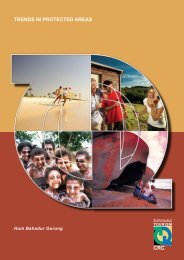icolls - Sustainable Tourism CRC
icolls - Sustainable Tourism CRC
icolls - Sustainable Tourism CRC
You also want an ePaper? Increase the reach of your titles
YUMPU automatically turns print PDFs into web optimized ePapers that Google loves.
ECOLOGY, THREATS AND MANAGEMENT OPTIONS FOR SMALL ESTUARIES AND ICOLLS<br />
Title of paper: Landscape-scale manipulations of water regime to rehabilitate coastal paperbark (Melaleuca<br />
ericifolia) swamps<br />
Author: Paul Boon<br />
Author's email: paul.boon@vu.edu.au<br />
Abstract: The eastern coast of Victoria is characterised by many shallow estuarine areas open only<br />
intermittently to the ocean (e.g. Lake Tyers, Sydenham Inlet). The largest of these systems is the Gippsland<br />
Lakes, which since the end of the 19th century has been opened permanently to the sea to facilitate navigation<br />
and professional fishing. The lakes system has become progressively more saline since the artificial opening was<br />
created, resulting in the loss of fringing marshes and swampland. These threatened wetlands are Ramsar-listed<br />
and important recreational (water-bird hunting) sites. We are currently trialling landscape-scale experimental<br />
changes (1,500 ha) to water regime in order to determine the relative impacts of various threats to the wetland<br />
systems (e.g. inappropriate water regime, increasing salinity, acid-sulfate soils, presence of carp, and nutrient<br />
enrichment via roosting birds) using a BACI experimental design. Both on-ground and remote-sensing (aerial<br />
photography and satellite imagery) approaches are used to quantify responses to shifts in water regime and<br />
salinity. The intention is to use this information, together with complimentary glasshouse experiments, to<br />
rehabilitate the fringing wetlands, in concert with active revegetation trials undertaken by the local community.<br />
Results indicating the pre-drawdown condition (2003) will be compared with preliminary results from the first<br />
year of water-regime manipulation.<br />
Title of paper: Wrack: a gross source of nutrients in some ICOLLs<br />
Author: Robert Dalton, W Maher and D Williams<br />
Author's email: dalton@scides.canberra.edu.au<br />
Abstract: There are many small ICOLLs on the South-East Coast of Australia. They are subject to pressure<br />
from urban and rural development, yet we know little about their biogeochemical cycles, their biota or their<br />
value to fisheries. We need information about their basic functioning so as to minimise damage from<br />
development in their catchments. We studied macroinvertebrates, algae and physicochemical parameters, such as<br />
dissolved oxygen, nutrient concentrations and salinity, in a series of ICOLLs over a 24 month period in order to<br />
determine relationships between the abundance and diversity of macroinvertebrates and the prevailing<br />
conditions. For two of the four ICOLLs, wrack appears to be a major source of nutrients. In one small urban<br />
ICOLL, Wimbie Creek, of the order of 600 tonnes of seaweed was washed into a lagoon volume of less than 1<br />
megalitre. The water of the lagoon became completely anoxic, with redox potential of less than –300 mV in the<br />
top 10cm of water. Some of the wrack was buried by sand and subsequently methane vents appeared in the<br />
bottom of the lagoon expressing at their peak over 200 litres a minute of methane. Some vents were still<br />
operating 5 months later. Wimbie Creek has a long history of odour problems. During the initial phase, no<br />
macrophytes grew in the lagoon but thick cyanobacteria (Oscillatoria) mats appeared on the edges. There were<br />
no macroinvertebrates found in these conditions. Eventually, after much tidal flushing the macrophyte,<br />
Enteromorpha ralfsii, became dominant at densities high enough such that diurnal fluctuation of DO still<br />
produced anoxic conditions in the nocturnal water column. The only macroinvertebrates found in these<br />
conditions were a few chironomid midges in the shallows. When the lagoon closed again the macrophytes died<br />
and the cyanobacteria reestablished. These conditions do not appear to be unique in space or time. During this<br />
study, Quieriga Lagoon, a small ICOLL with a forested catchment, experienced similar but less extreme<br />
conditions. For local councils to manage problems such as odours they can be courageous and say that these are<br />
naturally occurring events and the local residents just have to put up with it. Or they can spend effort to reducing<br />
the build up of wrack. There are also health issues arising from the build up of the cyanobacteria and fish stock<br />
issues arising from fish kills.<br />
Title of paper: Classification of coastal lagoons in southeastern New South Wales using remotely sensed data<br />
and GIS<br />
Author: Simon Foster<br />
Author's email: foster@scides.canberra.edu.au<br />
Abstract: Coastal lagoons are classified as barrier estuaries that are periodically open to the ocean. They are<br />
bodies of shallow saline water semi-isolated from oceanic water by a barrier composed of sand that may be<br />
intermittently open or closed to the sea (ICOLLs), through one of more narrow channels. ICOLLs lagoons<br />
represent a highly variable transition zone between terrestrial, freshwater and marine, environments whose<br />
physical, chemical and biological attributes are in a state of flux. We have been classifying the various types of<br />
small (











